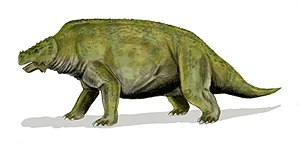Pareiasauridae
| Pareiasauridae | ||||||||||||
|---|---|---|---|---|---|---|---|---|---|---|---|---|

Live reconstruction of Scutosaurus |
||||||||||||
| Temporal occurrence | ||||||||||||
| Middle Perm to Upper Perm | ||||||||||||
| 272.5 to 251 million years | ||||||||||||
| Locations | ||||||||||||
|
||||||||||||
| Systematics | ||||||||||||
|
||||||||||||
| Scientific name | ||||||||||||
| Pareiasauridae | ||||||||||||
| Lydekker , 1889 |
The Pareiasauridae are early anapside reptiles . They lived from the Middle to the Upper Permian first in what is now southern Africa and then spread to Europe and Asia. All continents were united in the Permian to form the supercontinent Pangea . In their day they were the largest and heaviest land animals. The Pareiasauridae fell victim to the largest known mass extinction at the end of the Permian.
The different genera of the Pareiasauridae reached lengths of 60 centimeters ( Elginia ) up to 3 meters and, in the large forms ( Scutosaurus and Pareiasaurus ), an estimated maximum weight of 600 kilograms. They had massive, plump bodies with stocky legs. The tail was short. The head and parts of the body were provided with bony spikes and armor plates, probably for protection from predators. Potential predators were the Gorgonopsiden from the group of Therapsiden ("early mammalian relatives"). The Pareiasauridae were herbivores, their teeth resembling those of the herbivorous iguanas .
Until recently, some scientists suggested that tortoises are still living Pareiasauridae. The turtle shell is said to have developed from the bone plates of the Pareiasauridae. In the meantime, recent studies have placed the turtles in close proximity to the reptiles living today.
Genera
- Anthodon
- Arganaceras
- Bradysaurus
- Deltavjatia
- Elginia
- Embrithosaurus
- Nanopareia
- Nochelesaurus
- Pareiasaurus
- Pareiasuchus
- Scutosaurus
- Shihtienfenia
- Velosauria
literature
- Oskar Kuhn : Cotylosauria (= Handbook of Paleoherpetology. Vol. 6). Gustav Fischer Verlag et al., Stuttgart et al. 1969.
- Michael SY Lee: Pareiasaur phylogeny and the origin of turtles. In: Zoological Journal of the Linnean Society. Vol. 120, No. 3, 1997, ISSN 0024-4082 , pp. 197-280, doi : 10.1111 / j.1096-3642.1997.tb01279.x .
- Michael de Braga, Olivier Rieppel : Reptile phylogeny and the interrelationships of turtles. In: Zoological Journal of the Linnean Society. Vol. 120, No. 3, 1997, pp. 281-354, doi : 10.1111 / j.1096-3642.1997.tb01280.x .
- Robert L. Carroll : Paleontology and Evolution of the Vertebrates. Thieme, Stuttgart et al. 1993, ISBN 3-13-774401-6 , p. 205.
Web links
- University of California Museum of Paleontology: Introduction to Pareiasauria An Upper Permian group of Anapsids
- University of California Museum of Paleontology: Pareiasauria - More on Morphology
- Palæos: Pareiasauria